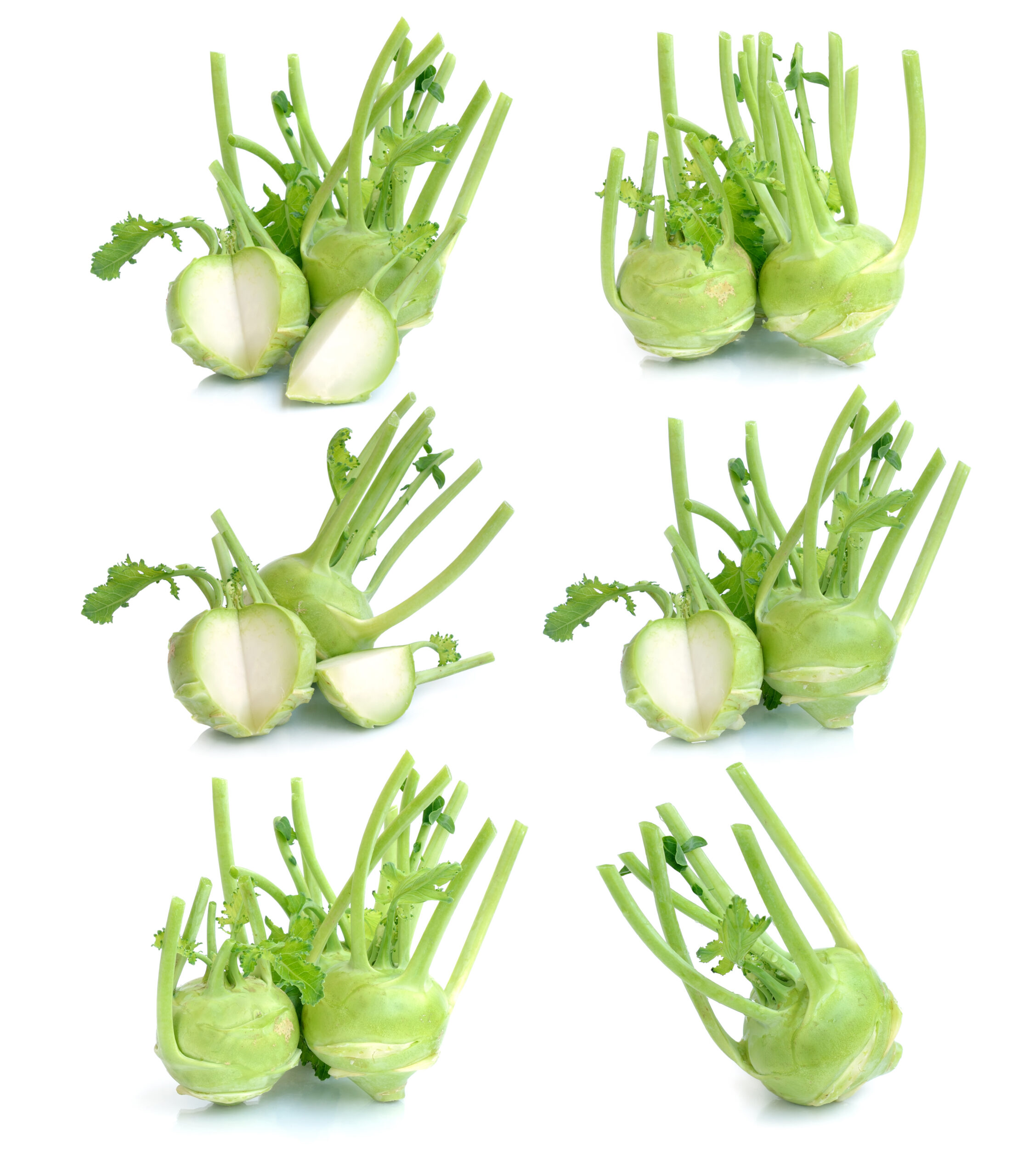Yes, it’s true. Kohlrabi looks like a species from Mars with its green (or even purple) bulb and thin stems and leaves that shoot out from all sides of it like creepy feelers. But folks this is no vegetable from a Hollywood movie set, this is a truly delicious earth grown gem. Its name is German for “cabbage turnip” and while it is a member of the cabbage family, it is not exactly a cabbage or a turnip. Many say the flavor of the bulb is similar to broccoli stem. I think of raw kohlrabi as a cross between broccoli stem and jicama with respect to both taste and texture.
While you don’t often see the whole form of the vegetable in stores, both kohlrabi bulbs and greens are edible, the flat greens being similar to collards in taste and texture. If you do see it with its greens attached, it means the kohlrabi is fairly fresh (especially if the greens appear healthy).
Kohlrabi bulbs become more fibrous as they grow in size, but smaller bulbs are wonderful raw. They can be used as a crudité with dip, shaved or chopped and added to salads, or grated and used in coleslaw (squeeze out excess water). Smaller bulbs do not need to be peeled. A very versatile vegetable, the bulbs are great sautéed, fried, boiled and pureed, cooked into soups and stews, and roasted. They are similar to turnips but give off more water when cooked. The bulb peels easily after being cooked.
Kohlrabi leaves are great cooked like any other leafy green. Try them sautéed with olive oil and garlic, or tossed into sauces and soups. You can also steam or saute the greens as you would any other green (add a bit of liquid), or you can add them to soups/stews at the end of cooking. They would also be good raw, slivered and added to grain salads.
Kohlrabi is high in vitamin C (100g yields 102% RDA) and fiber, and also contains significant amounts of folic acid, potassium and magnesium. It is a very low calorie food, with only 27 calories per 100g. It also contains phytonutrients like isothiocyanates and sulforaphane that protect against certain cancers.
Choose small bulbs (1-3 inches) with green, lively leaves. To store, trim leaves from bulbs and store both separately in plastic or reusable produce bags. Greens will only last a couple of days but the bulbs will keep a couple of weeks. If you are peeling your kohlrabi it helps to smooth out its surface with a knife before trying to use a vegetable peeler on the knobby, uneven skin or you can find yourself cutting up your hands.
*********************************************************
This recipe was highly adapted from a broccoli recipe in the November 2015 issue of Cooking Light. I added curry powder to get more healing turmeric into my diet and because curry pairs so well with raisins. I also added pomegranate for its lovely color and juicy pop. This would make a great dish for a holiday table.
Curry Roasted Kohlrabi with Pomegranate & Pickled Golden Raisins Serves 4
INGREDIENTS:
– 6 cups Kohlrabi, peeled, 1/2″ dice (about 2 med/lg)
– 1 1/2 tablespoons coconut oil, melted
– 2 teaspoons curry powder, or more to desired taste
– 1/4 heaping teaspoon sea salt
– 1/8 teaspoon freshly ground black pepper
– 1/2 cup cider vinegar
– 1/4 cup water
– 1 tablespoon mustard seeds
– 1/3 cup golden raisins
– 1 large shallot, thinly sliced
– 3 tablespoons toasted pistachio nuts
-3 tablespoons fresh pomegranate arils
METHOD:
- Preheat oven to 400. Place kohlrabi cubes in a large bowl. Toss with coconut oil, sea salt, pepper and curry powder. Taste and add additional seasoning if desired. Place evenly on a large rimmed baking sheet sprayed with coconut oil spray. Cover with foil. Bake for 15 minutes. Remove foil, turn kohlrabi pieces and continue to bake, uncovered. Turn once or twice more, until kohlrabi is tender and nicely caramelized.
- While kohlrabi is roasting, place cider vinegar, water, mustard seeds, golden raisins, and shallot in a small saute pan and bring to a boil. Boil for 2 minutes. Turn out into a sieve placed over a bowl or in the sink. Drain off and discard vinegar broth.
- Once kohlrabi is done cooking transfer it to a large serving bowl. Taste and add additional salt and pepper if needed. Toss in pickled raisins and shallots, and then sprinkle with pistachios and pomegranate seeds. Serve immediately. (If you wish to make this dish ahead, refrigerate without the pistachios and pomegranate. Reheat and then add them to the dish before serving).
Julie Wern is a psychologist turned stay-at-home-mom turned caterer. She is currently in training at the Institute of Integrative Nutrition to become a Nutrition and Wellness coach. She is the author of Holcomb Farm CSA’s Simply Fresh blog (http://holcombfarm.org/blog)and currently teaches cooking and cookie decorating classes. Contact Julie at jwern@comcast.net for comments and inquiries.
